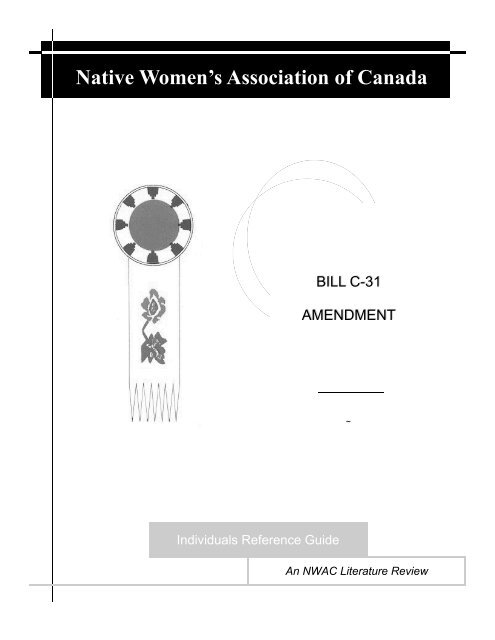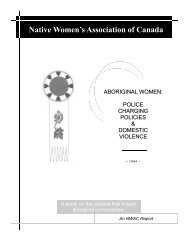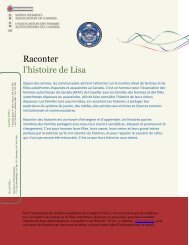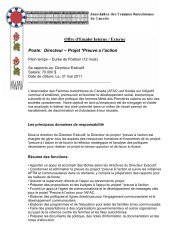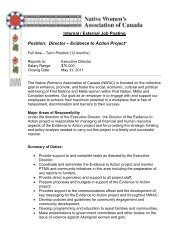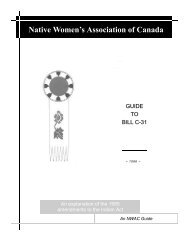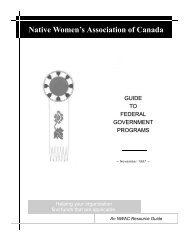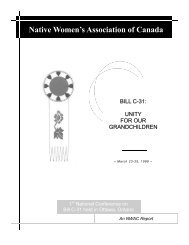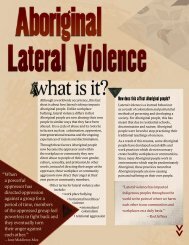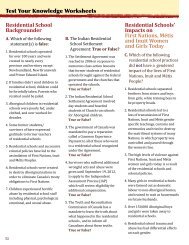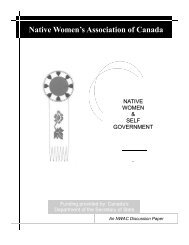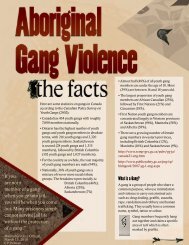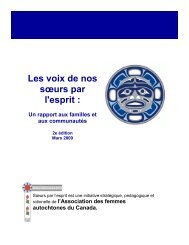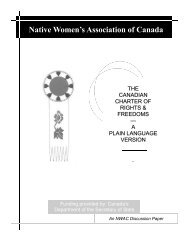Literature Review - Native Women's Association of Canada Website
Literature Review - Native Women's Association of Canada Website
Literature Review - Native Women's Association of Canada Website
Create successful ePaper yourself
Turn your PDF publications into a flip-book with our unique Google optimized e-Paper software.
5. Basic Departmental Data - 1999Section one <strong>of</strong> the First Nations and Northern Statistics Section Corporate InformationManagement Directorate Information Management Branch provides Bill C-31populations in the following perspectives:5. Annual Percentage Change in Registered Indian population, <strong>Canada</strong>,1974 - 19986. Registered Indian Population Distribution by On/Off Reserve Residence,<strong>Canada</strong>, 1892, 1987, 1992, 1998,2003 and 2008, (population projections).7. Bill C-31 Population8. Population by Region6. Bill C-31: Its Impacts, Implications and Recommendations for Changein British Columbia: Final ReportWritten by Audrey Huntley and Fay Blaney with the assistance <strong>of</strong>: Rain Daniels,Elizabeth Hall and Jennifer Dysart. A project <strong>of</strong> the Aboriginal <strong>Women's</strong> Action Network(AWAN). December 1999. c/o Vancouver Status <strong>of</strong> Women.This report examines the effects <strong>of</strong> Bill C-31 on the lives <strong>of</strong> <strong>Native</strong> women in BritishColumbia. It involved many stages, each including a high degree <strong>of</strong> consultation with<strong>Native</strong> women affected by the legislation and/or working to change it.7. "Bill C-31 Equality or Disparity? The Effects <strong>of</strong> the New Indian Act on<strong>Native</strong> Women" Canadian Advisory Council on the Status <strong>of</strong> Womenby Joan HolmesA background paper titled "Bill C-31 Equality or Disparity? The Effects <strong>of</strong> the New IndianAct on <strong>Native</strong> Women" was written in 1987 by Joan Holmes. The Canadian AdvisoryCouncil on the Status <strong>of</strong> Women commissioned the background paper on the impact <strong>of</strong>Bill C-31 to help women's groups, both native and non-native, to understand how thechanges to the Indian Act will effect Indian women. The paper focused on the impact onwomen, because the majority <strong>of</strong> Indians who lost their status were women. Theinformation for this paper was gathered from position papers presented by nativeorganization. Interviews were done with women who were reluctant to have themselvesor their communities identified. Several government <strong>of</strong>ficials, who also providedinformation on program and policies, requested that they too not be identified due topolitical sensitivity.Pg. 7
This paper concluded that Bill C-31 had made pr<strong>of</strong>ound changes to the Indian Act thatwill affect the rights <strong>of</strong> Indian people to be recognized as Indians and to belong tobands. Although blatant discrimination against Indian women had been removed fromthe Act, the effects <strong>of</strong> that discrimination persisted, an new areas <strong>of</strong> inequality arose. Itmentioned two types <strong>of</strong> status, one <strong>of</strong> which is difficult for a parent to transmit to her/hischildren, also that it will affect all Indians, male and female, by limiting the number <strong>of</strong>Indians eligible for status. Further, it mentions that some women have had difficultiesgetting services and benefits their bands or exercising their rights as reinstated badmembers, and at the time, they feared that their rights and the rights <strong>of</strong> their children areignored by bands and that they have no protection. Many women felt that the charter <strong>of</strong>rights and freedoms, or a similar Indian rights charter, need to be applied to all bandmembership codes, review processes, and protest provisions to assure that on one isunfairly treated. Treatment <strong>of</strong> children <strong>of</strong> single mothers is a strong concern for manyIndian women who believe that where there is no father present, children should receivetheir status and band membership though their mother only. It also concluded,organizations and individuals had identified a need for information and assistanceprograms to help eligible people to follow up their applications access benefits, and toassist bands to understand the amendments and to develop membership codes. Onlyafter most <strong>of</strong> the applications for registration have been processed and will anassessments <strong>of</strong> the impacts be possible.8. Bill C-31 Unity <strong>of</strong> our Grandchildren Conference ProceedingsAfter Bill C-31: Unity for our Grandchildren Conference was held March 23-25th, 1998 inOttawa, Ontario, hosted by <strong>Native</strong> <strong>Women's</strong> <strong>Association</strong> <strong>of</strong> <strong>Canada</strong>, a document wasput together by the <strong>Association</strong>. This document explains the processes <strong>of</strong> what tookplace through its three day duration. It provides the litigation background <strong>of</strong> Gail Stacy-Moore and Sharon Mclvor litigation (<strong>Native</strong> <strong>Women's</strong> <strong>Association</strong> <strong>of</strong> <strong>Canada</strong> al. v.<strong>Canada</strong> (1992), 53 F.t.r.1994).Day one <strong>of</strong> the conference began with guest speakers. Tony Belcourt from MétisNational Council; Harry Daniels for the Congress <strong>of</strong> Aboriginal Peoples; Allice Jeffery,hereditary Chief <strong>of</strong> the Gitksan People; Joan Holmes. Participants stories and Legalpanel presentations also took place on the first day.Day two consisted <strong>of</strong> three workshops; Impediment to Inequality; ResidualDiscrimination Relating to Bill C-31 and National International Rights Implications. Daythree concluded with summary reports followed by a discussion <strong>of</strong> strategy, where therewas an expression <strong>of</strong> momentum in terms <strong>of</strong> following up on the conference. It wasnoted that Bill C-31 is an issue for all and must be addressed, resolutions were made,the following was added in this document:1. That the NWAC file a class action suit against the federal government andFirst Nations with restrictive membership codes.Pg. 8
11. Enough is Enough: As Women Speak OutEnough is Enough: Aboriginal Women Speak Out is a book written by Janet Silman. Itconsists <strong>of</strong> Stories are told by a group <strong>of</strong> women from Tobique Reserve in NewBrunswick on how they struggle with fighting against the discrimination they facedbecause they married non-<strong>Native</strong>s. This two part book reveals how the Tobique womenactually began to form as an "entity" in the mid 70's, not initially to change the IndianAct, but to improve local living conditions for women and children. In Chapter one,individual women recall what growing up on the reserve was like for them. Chapter twotraces the growing awareness women were gaining in the early to mid-1970's <strong>of</strong> theinjustices they bore as women and the subsequent movement for consciousness toaction. In Chapter three the women recall those emotionally-charged times where theyrapidly learned to value publicizing their story. Tobique women were unaware <strong>of</strong> the farreachingimplications <strong>of</strong> marring out until they later sought to move back to the reserve.Chapter four covers the walk, the chain <strong>of</strong> events leading up to it and the continuingprotests continuing into 1980. In 1981 the U.N. Human Rights Committee ruled inSandra Lovelace's favor. In Chapter five, the women most involved in lobbying recall thehigh and low points <strong>of</strong> their determined campaign to change the Indian Act. It is a story<strong>of</strong> truly strong women who have survived hard times and overcome tremendous odds toregain their Indian birthrights. Very good book.12. Entitlement to Indian Status and Membership CodesThis Book written by Larry Gilbert is a two part manual that discusses, Law <strong>of</strong>Entitlement (Indian Status) Under the Indian Act and Membership Codes. Part onediscusses the Department <strong>of</strong> Indian Affairs and Northern Development; Concepts informer versions <strong>of</strong> the Indian Act and the related rights under the new Act; The 1985Indian Act; Customary Law; the Application Process; Protests and Appeals (Protest, theInvestigation, The Duty <strong>of</strong> Fairness and Natural Justice, Appeals and the Powers toApply Section 52 <strong>of</strong> the Constitution). Part two discusses Section 10 <strong>of</strong> the Indian Act;Steps a First Nation must complete in order to assume control <strong>of</strong> its membership;excerpts from existing First Nation Membership Codes (preamble, purpose/objects,definitions, eligibility for membership, First Nations who assumed membership,application procedure, ceasing to be a member, appeals procedures, administrativematters, amendments, case law concerning membership, and Membership codes, theIndian Act and the Canadian Charter <strong>of</strong> Rights and Freedoms.13. "Equality for all in the 21st Century": 2nd National Conferenceon Bill C-31This is a report <strong>of</strong> the 2nd National Conference on Bill C-31, it was said to be asuccessful conference, achieving its objectives with high participation. The workshopsled by the facilitators resulted in fifty-two recommendations, which was said to form abasis <strong>of</strong> the strategy, along with the five recommendations from the first conference.The plenary sessions <strong>of</strong> the conference were video taped, and mention <strong>of</strong> adocumentary will be produced for community distribution. It makes mention to thePg. 10
enthusiastic moments <strong>of</strong> the conference, which were the key speakers. It also makesmention that AFN and MNC were notably absent. A Summary <strong>of</strong> SpecificRecommendations, for the purpose <strong>of</strong> presentation were organized into six categories,which were: Legal; Immediate and Ongoing Action; Communication and Networking;Research and Consultation; Political and Advocacy; International Approaches andAlliances. In summary <strong>of</strong> these recommendation, it was clear that the expectations <strong>of</strong>both <strong>of</strong> the Assembly participants with to see the NWAC take a lead role inimplementation <strong>of</strong> the strategy for a variety <strong>of</strong> reasons. I was clear that in order t<strong>of</strong>urther carry out the direction <strong>of</strong> the people, there must be a continuance <strong>of</strong> financialresources with at strong commitment for the federal government to do so. There mustbe a coordinating body, supported by technical resources to enable the extensive workthat must be done to fulfill the mandate given through these gatherings. It is clear thatthere is very little support from the aboriginal community especially after it is understoodwhat the total impact <strong>of</strong> the bill is and what it is designed to do. A process <strong>of</strong>consultation research and communications and networking must take place and befunded by the appropriate government bodies. The process <strong>of</strong> healing was alsomentioned in this report, where this legislation has made a dramatic and long termeffect upon the lives <strong>of</strong> every individual within our Nations, in order to gain dignity andrespect that belongs to everyone.14. First Nation Information ProjectThis site provides various informative links on First Nation Issues. This particular paperon Bill C-31 provides an overview on the amendment. It mentions the Registration(status), Band Membership; New Bylaw Powers such as the Section 81 <strong>of</strong> the IndianAct; enfranchisement Abolished; Intoxicants; and Funding. It also makes mention <strong>of</strong> atwo year review submitted to the Parliamentary Committee in June 1987. In general thissite on Bill C-31 serves as an information sheet. http://www.johnco.com/bill_c31.html.15. First Nations Chiefs <strong>of</strong> Police <strong>Association</strong>http://www.soonet.ca/fncpa/hrdc/mod2-3/module2.htmPolicing Sector Study Module 2 & 3 Summary Report Sixdion Inc. (Six Nation Company)August 22, 2000The Module 2&3 Summary Report was written by Sixdion based on researchundertaken by previous consultants in 1999/2000 for the First Nations Chiefs <strong>of</strong> Police<strong>Association</strong> (FNCPA). In some communities where there has been an increase inpopulation as a result <strong>of</strong> Bill C-31, certain "types" <strong>of</strong> crime have emerged. Some PoliceServices attribute this to the fact those individuals who have lived in the city all <strong>of</strong> theirlife are now moving to the First Nations communities and bring with them a more"experienced" urban perspective on crime. In some cases this has resulted in anincrease in sophisticated criminal activities (Report).Pg. 11
16. Frosty Amerindian Indian Acthttp://www.mail-archive.com/frostysamerindian%40yahoogroups.com/msg01056.htmlNotes on the Indian Act Date: Wed, 09 May 2001It states in these notes that with section 15 -- the equal rights provision <strong>of</strong> the Charter --coming into effect in April, 1985, Bill C-31 was enacted to remove the discriminatoryprovisions: R.S.C. 1985, c. 32 (1st Supp.). In fact, Bill C-31 went much further,reinstating those who had previously lost status and their children. This move greatlyincreased the status Indian population, creating increased demands upon communityand government resources which have yet to be resolved. In the current act, there is novoluntary or involuntary enfranchisement and marriage is a neutral act: no one gains orloses status. In 1985, there were approximately 300,000 status Indians. In 1996, thenumber is more like 600,000.17. Globe Conferences: <strong>Native</strong> Canadians: What Next?http://forum.theglobeandmail.com/nc_January98_March98.html #4 <strong>of</strong> 76 by:Clayton Sun 11 Jan '98 (08:51 PM)Cultural Genocide: <strong>Canada</strong>'s Final Solution? These provisions were included in the firstIndian Act <strong>of</strong> 1876 and were not rescinded until 1985. Since then nearly 100,000 Indianwomen and their children have been reinstated under Bill C-31 as Indians. A lateramendment, in 1920 gave the government the power to strip Indians <strong>of</strong> their legal statusas Indians by forcibly enfranchising those Indians that it felt were ready for such achange. If a man were enfranchised under this amendment, his whole family wasenfranchised with him.18. "Hear Their Stories" 40 Aboriginal Women SpeakThis is a final report written in 19971 by Claudette Dumont-Smith, for The <strong>Native</strong><strong>Women's</strong> <strong>Association</strong> <strong>of</strong> <strong>Canada</strong>. It is a three part report. Part one is a literature review.Part two provides Stories from 40 Aboriginal women. The issue was Elder Abuse <strong>of</strong>Aboriginal female seniors in <strong>Canada</strong>. The third part discussed an Action Plan. Thereason this article was include with this paper, is because it holds some stories fromwomen who experienced the Bill C-31 effects. An interesting report.19. Indian Status and Band Membership IssuesThis document was prepared by Jill Wherrett, Political and Social Affairs Division in1996, for general distribution for Canadian Parliamentarians for a background andanalysis <strong>of</strong> issues that may rise in the course <strong>of</strong> their parliamentary duties. They aremade available on the website as a service to the public. The document examines some<strong>of</strong> the current issues surrounding Indian Band Membership. It surveys Indian Actprovisions regarding status and Band Membership and the changes introduced throughPg. 12
the Bill C-31, it also discusses some <strong>of</strong> the consequences <strong>of</strong> the Bill and outlines recentcourt cases (Courtoire, Corbiere, Sawridge Band and Goodswimmer) that focus onband implications <strong>of</strong> the resulting judgments and comments on membership issues onthe context <strong>of</strong> self government for Indian communities.20. Lakeland Aboriginal Issues Task ForceLakeland Aboriginal Issues Task Force formed in 1997. The key objectives <strong>of</strong> thisproject was to available to all interested aboriginal people in the constituency, includinggrass roots citizens as well as chiefs chairmen, councils, and elders, in order to heartheir concerns and problems; to seek the thoughts, ideas and opinions <strong>of</strong> all thesepeople as to how, on a practical, day to day level, changes could be made to deal withthese concerns; to take a concise summary <strong>of</strong> these suggestions to the Minister <strong>of</strong>Indian Affairs. The purpose <strong>of</strong> the project was to carry their practical suggestionsdirectly to the Minister, in hopes <strong>of</strong> finding lasting solutions. They resolved to makegrass roots voices heard on Parliament Hill. They produced a report that containedrecommendations and were brought to four main categories which were: Financialaccountability; Democratic Accountability; Education; and Membership and the Impact<strong>of</strong> Bill C-31. Recommendation 6 is subtitled, 'The Government Must Require Bands toExtended Full and Equal Rights to those Whose Membership has Been Reinstatedunder Bill C-31'. This can be viewed by going to: http://www.leonbenoit.com/lakeAborTaskForceReport/recs.htmI.21. <strong>Native</strong> American Indian Resources1986 Canadian Ethnic Population distribution (Excerpt from this site)... I wonder if these<strong>Native</strong> leaders are now planning legal action against the Creator, for similarly failing toconsult them when new human beings come into the world, babies whose parentagemakes them -- without any consultations with these sovereign <strong>Native</strong> leaders! --automatically Band members. Why, some <strong>of</strong> those undesirable new First Nation citizensare sure to grow up to be troublemakers, who won't follow those fat cat <strong>Native</strong> leadersfor their little handouts like good little Indians are supposed to... http://www.kstrom.net/isk/maps/canpop.html22. <strong>Native</strong> Women: “A Voice <strong>of</strong> Many Nations” Recognizing Our OwnBy Nadine HayesThis was a short publication written by a summer student for the <strong>Native</strong> <strong>Women's</strong><strong>Association</strong> <strong>of</strong> <strong>Canada</strong> in 1985. It provides a history <strong>of</strong> the <strong>Native</strong> <strong>Women's</strong> <strong>Association</strong><strong>of</strong> <strong>Canada</strong>, and the Past Executive and Board members. It is one <strong>of</strong> NWAC'spublications.Pg. 13
23. <strong>Native</strong> Women Rail Against Bill C-31by Duncan ThorneEdmonton Journal, Staff Writer (May 17th, 1999) quotes, at the time, President MarilynBuffalo: "The government's action plan is to legislate away our rights by attacking(native) women and children directly". It also makes reference to the conference held inEdmonton, Alberta on May 14th, 15th and 16th, 1999.24. Report to Parliament on the Impacts <strong>of</strong> the 1985 Amendments to theIndian Act (Bill-C-31).ARC (Applied Research Consultants) prepared a Report to Parliament on the Impacts<strong>of</strong> the 1985 Amendments to the Indian Act (Bill-C-31). http://www.cfgroup.ca/arc/firstnations/ and http://www.cfgroup.ca/arc/firstnations/sr-c-31.html The report beginswith impacts on registrants as measured by changes in their circumstances. It thenexamines effects on bands and communities, as measured by changes in bandmembership, as well as consequences for individuals living on reserve. Effects on somenon-reserve native communities were examined separately. Finally, the impacts ongovernment programs as measured by the evolution <strong>of</strong> program expenditure arepresented. ARC was also involved in a study that projects New Registrations Under BillC-31 for the Assembly <strong>of</strong> First Nations. http://www.cfgroup.ca /arc/firstnations/pnr-c-31.html25. Report <strong>of</strong> the Royal Commission on Aboriginal PeoplesThe final report <strong>of</strong> the Royal Commission on Aboriginal Peoples provides a completestatement <strong>of</strong> the Commission's opinions on, and proposed solutions to, the manycomplex issues raised by the 16-point mandate set out by the Government <strong>of</strong> <strong>Canada</strong> inAugust 1991. Each <strong>of</strong> its five volumes presents the Commission's thoughts andrecommendations on a range <strong>of</strong> interconnected issues. Chapters are devoted to majortopics such as treaties, economic development, health, housing, Métis perspectives,and the North. Volume 5 draws all the recommendations together in an integratedagenda for change. The five volumes are entitled; Looking Forward, Looking BackRestructuring the Relationship; Gathering Strength; Perspectives and Realities;Renewal: A Twenty-Year Commitment… Volume 4, Perspectives and Realities, Chaptertwo looks at the <strong>Women's</strong> perspective. It presents a number <strong>of</strong> perspectives such asHistorical Position and Role <strong>of</strong> Aboriginal Women; Reversing a Pattern <strong>of</strong> Exclusions;Aboriginal Women and Policy (Policy Development and its impacts on Firs NationWomen, Bill C-31, and the Indian Act and Bill C-31); Health and Social Services; theNeed for Places <strong>of</strong> Refuge; The Rise <strong>of</strong> Aboriginal <strong>Women's</strong> Organizations; The Needfor Fairness and Accountability; and The Family.Pg. 14
26. Resume Outlining the Historical Development <strong>of</strong> the Administration<strong>of</strong> Indian Affairshttp://collections.ic.gc.ca/treaties/text/rec_e_tx.htmThis site refers to the 1985 - June 28 Bill C-31, An Act to Amend the Indian Act, wasproclaimed in the House. Changes were designed to remove sex discrimination fromthe Indian Act, abolish the concept <strong>of</strong> enfranchisement, and grant bands control overtheir own membership. The legislation expressed a change in direction for DIAND andemphasized Indian self-government, economic development, quality <strong>of</strong> community life,and protection <strong>of</strong> the special federal government / Indian relationship. A majorrestructuring <strong>of</strong> DIAND was begun to accommodate this change in direction. Theamendments were retroactive to Aprii17, 1985.27. 1989 Study on Bill C-31 ImpactsIn 1989 a study was begun to determine the impacts and to build a reliable base <strong>of</strong>information for use by both the government and notice people. It was developed andconducted in a unique consultation with national Aboriginal institutions, including theAssembly <strong>of</strong> First Nations, the <strong>Native</strong> <strong>Women's</strong> <strong>Association</strong> <strong>of</strong> <strong>Canada</strong>, and the <strong>Native</strong>Council <strong>of</strong> <strong>Canada</strong>. Four research reports were the result <strong>of</strong> this study. Through thestudy there was key areas <strong>of</strong> Program Impact. Housing Health Post SecondaryEducation, Social Services Requirements, Land Management and EmploymentOpportunities. Major areas <strong>of</strong> concern included were: Discrimination Under Bill C-31Provisions; Control over and Membership Lists; Fear for the Future, and Funding.The study reports are titled as: Impacts <strong>of</strong> the 1985 Amendments to the Indian Act (Bill C-31) Survey <strong>of</strong> Adult Bill C-31 Registrants (Module 2) Impact on the Indian Band,Tribal Council and Off-reserve Communities (Module 3) Report <strong>of</strong> the National Aboriginal inquiry on the Impact <strong>of</strong> Bill C-31 Impact <strong>of</strong> the 1985 Amendments to the Indian Act (Bill C-31) SummaryReport Info about Government Program and Statistics (Module 4)28. Turtle Island <strong>Native</strong> Network NewsBy James ParkerTurtle Island <strong>Native</strong> News had cited an article that appeared in the Saskatchewan StarPhoenix, October 22, 1999, written by James Parker. It mentions the decision in favour<strong>of</strong> Mary Vicky Scrimbitt. Judge Andrew Mackay said the Sakinmay Indian Band Councilviolated the Indian Act, its own band membership code and the Charter <strong>of</strong> Rights andFreedoms when it struck Scrimbitt's name from its voting list. They were ordered torestore Scrimbitt's voting rights for future band elections.Pg. 15
29. The Canadian Journal <strong>of</strong> <strong>Native</strong> StudiesThe Indian Act: A Northern Manitoba Perspective Robert Robson, Department <strong>of</strong>History, Brandon University writes an article published in the Canadian Journal <strong>of</strong> <strong>Native</strong>Studies on Bill C-31. He notes that Bill C-31 has neither met its intended objectives noradequately dealt with the needs <strong>of</strong> the Aboriginal population.30. The Indian Act Exemption - Options for Reforming the CanadianHuman Rights Act - Summary prepared by Larry N. ChartrandThe Canadian Human Rights Act <strong>Review</strong> Panel is conducting a full review <strong>of</strong> theCanadian Human Rights Act (CHRA). The Minister <strong>of</strong> Justice has requested acomprehensive report with recommendations for changes to the CHRA by April, 2000.One specific portion <strong>of</strong> this review involves s.67 <strong>of</strong> the CHRA which exempts the IndianAct or any provision made under or pursuant to it from the application <strong>of</strong> the CHRA. Thispaper is designed to promote discussion and dialogue on whether s.67 is meeting theneeds <strong>of</strong> Aboriginal peoples and Canadians. In particular should the exemptionprovision be repealed, modified, strengthened or remain unchanged? Various optionsfor reform are presented for discussion and feedback…A number <strong>of</strong> claims have beenmade against Band Councils for discrimination. These claims <strong>of</strong>ten involve restrictionson services or membership to individuals reinstated by Bill C-31 or their children. Insome cases, non-Indian spouses or non-Indian adopted persons living on reserve havebeen discriminated by Band Councils. In other cases, Band members living <strong>of</strong>f-reservehave been denied services. If a Band Council is able to show that their discriminatoryactions or decisions are made pursuant to the Indian Act, then the CHRA will not applyto the case and the complainants will not be able to obtain a remedy. If the BandCouncil is unable to prove that their decision or action was made pursuant to the IndianAct, then the CHRA will apply (http://www.chrareview.org/pubs/indact1e.html.)31. The Politics <strong>of</strong> Legislated Identity by Pam PaulThe Politics <strong>of</strong> Legislated Identity was prepared by Pam Paul, for the Atlantic PolicyCongress Of First Nations Chiefs. The report was intended to be a discussion paper forthe Atlantic Policy Congress <strong>of</strong> First Nations, which consists <strong>of</strong> two parts. Part one,consists <strong>of</strong> defining the Issue <strong>of</strong> the Bill C-31 amendment, which gave backgroundinformation on the amendment; information <strong>of</strong> the rules for establishing Indian Status; aliterature review <strong>of</strong> three major reports that were completed; it made reference to twocourt case; Population <strong>of</strong> 6(2) individuals in the Atlantic Provinces along with casesamples that helps to understand the types <strong>of</strong> situations people are in. Part two, titled"First Nations Government and Constitution: Building the Process" Gives a background<strong>of</strong> the Royal Commission on Aboriginal Peoples' findings, where it recognizes that FirstNations must create their government institutions as a Nation and begin a Nationbuilding process. The other items explained were, what Constituted Cultural Identity,What is Membership, and the First Nations Constitution. Included with the two partdescription <strong>of</strong> the situation in the Atlantic Region, were four recommendations. Itincluded, where an examination <strong>of</strong> the Atlantic communities numbers <strong>of</strong> 6(2) registrantsPg. 16
must be undertaken to determine if they are better <strong>of</strong>f/worse <strong>of</strong>f than the national ratios;to develop proper constitutions which define who their citizens are; examining Micmac,Maliseet traditional methods <strong>of</strong> identity; and defining areas <strong>of</strong> equalization payments.Included with this report were appendices <strong>of</strong> registered population in Atlantic Provinces;projected population graphs and inheritance rules diagrams and graphs.32. Thesis CollectionA Sociological Analysis <strong>of</strong> Bill C-31 LegislationWilson, Jack (1998) A Sociological Analysis <strong>of</strong> Bill C-31 Legislation. A thesis submittedto the college <strong>of</strong> Graduate Studies and Research in Partial fulfilment <strong>of</strong> the requirementsfor the degree <strong>of</strong> masters <strong>of</strong> Arts in the Department <strong>of</strong> Sociology, University <strong>of</strong>Saskatchewan, Saskatoon.Exploring Identity and Citizenship: Aboriginal Women. Bill C-31 and the Sawridge CaseGreen, Joyce Audrey (1997) Exploring Identity and Citizenship: Aboriginal Women. BillC-31 and the Sawridge Case. A thesis submitted to the Faculty <strong>of</strong> Graduate Studies andResearch in partial fulfillment <strong>of</strong> the requirements for the degree <strong>of</strong> Doctor <strong>of</strong>Philosophy. Department <strong>of</strong> Political Science. Edmonton, Alberta.The Trojan Horse: an analysis <strong>of</strong> the Social, Economic and Political Reaction <strong>of</strong> FirstNation People as a result <strong>of</strong> Bill C-31Paul, Pamela (Sept 1990) Bill C-31: The Trojan Horse: an analysis <strong>of</strong> the Social,Economic and Political Reaction <strong>of</strong> First Nation People as a result <strong>of</strong> Bill C-31. A ThesisSubmitted in partial Fulfillment <strong>of</strong> the Requirements for the Degree <strong>of</strong> Masters <strong>of</strong> Arts inthe Department <strong>of</strong> Anthropology. The university <strong>of</strong> New Brunswick Pg.115.Who and what is a Canadian Indian? The Impact <strong>of</strong> Bill C-31 upon demographic andepidemiologic measures <strong>of</strong> the registered Indian population <strong>of</strong> ManitobaIsfeld, harper. (1997) Who and what is a Canadian Indian? The Impact <strong>of</strong> Bill C-31 upondemographic and epidemiologic measures <strong>of</strong> the registered Indian population <strong>of</strong>Manitoba. A thesis submitted to the Faculty <strong>of</strong> Graduate Studies in partial fulfillment fothe requirements for the degree <strong>of</strong> Masters <strong>of</strong> Arts. Department <strong>of</strong> Anthropology.University <strong>of</strong> Manitoba. Winnipeg, Manitoba. Pg.110."Real" Indians and others: Mixed Race Urban <strong>Native</strong> PeopleLawrence, Bonita (1999) "Real" Indians and others: Mixed Race Urban <strong>Native</strong> People.The Indian Act and the Rebuilding <strong>of</strong> Indigenous Nations. A thesis submitted inconformity with the requirements for the degree <strong>of</strong> Doctor <strong>of</strong> philosophy, Department <strong>of</strong>Sociology and Equity Studies, Ontario Institute for Studies in Education <strong>of</strong> the University<strong>of</strong> Toronto.Pg. 17
33. Virtual Law Office: Bill Hendersonhttp://www.bloorstreet.com/200block/brintro.htmThis site is with an Ontario lawyer providing a range <strong>of</strong> services to clients from severalprovinces, including general litigation and advice on issues <strong>of</strong> Aboriginal, treaty andother rights and concerns <strong>of</strong> First Nations.Henderson writes, It was the Constitution Act, 1982 that finally forced change. Section 15,the equality provision <strong>of</strong> the Charter, came into effect in April <strong>of</strong> 1985 and it wasrecognized that the differential treatment <strong>of</strong> Indian men and women would not surviveanother challenge. Bill C-31, enacted to come into effect before the Charter, not onlyended any status consequences <strong>of</strong> marriage (no gain, no loss) but also restored status tothose who had previously lost it and their children. <strong>Canada</strong> greatly underestimated thenumber <strong>of</strong> individuals who would become entitled to Indian status and Band membership.The result was a major change in the demographics <strong>of</strong> some Indian communities, insome cases more than doubling the membership rolls. The Twinn case challenged Bill C-31 on the basis <strong>of</strong> its incursion on tribal rights <strong>of</strong> self-government, but the Federal CourtTrial Division rejected that challenge in 1995. The decision is under appeal (Henderson).34. Where are the Women?Mavis A Erickson, BA., LL.B., LL.M. January 12, 2001This is a Report <strong>of</strong> the Special Representative on the Protection <strong>of</strong> First Nations<strong>Women's</strong> Rights. Written for the Honourable Minister Nault in Satisfaction <strong>of</strong> the SpecialRepresentative Requirement.This report consists <strong>of</strong> a Historical Background; a special representative process whichinvolved focus groups at each region. The report provides a consolidated summary <strong>of</strong>the focus group sessions. It notes three critical areas <strong>of</strong> concern: The administration <strong>of</strong>the Indian Act, potential gaps in the Indian Act; and areas outside the Indian Act thatmay challenge the new relationship.35. Visions <strong>of</strong> the Heartby David Long and Olive Patricia DickasonSecond Edition <strong>of</strong> Visions <strong>of</strong> the Heart provides information about Canadian AboriginalIssues. Chapter four discusses Contemporary Aboriginal Women in <strong>Canada</strong> AboriginalWomen in <strong>Canada</strong> and the Law, from the <strong>Native</strong> Law Center <strong>of</strong> <strong>Canada</strong>. This chapterprovides a brief description <strong>of</strong> the subject, as well as a select bibliography and links.Attorney-General <strong>of</strong> <strong>Canada</strong> v. Lavell and Isaac v. Bedard - text <strong>of</strong> the proceedings."<strong>Canada</strong>'s Experience with United Nations Human Rights Treaties" by Philippe LeBlanc.It includes a description <strong>of</strong> the Sandra Lovelace case (in section V); an informationsheet on Bill C-31 from the federal government. "Aboriginal Women & Bill C-31," a briefarticle from Action Now! Newsletter <strong>of</strong> the National Action Committee on the Status <strong>of</strong>Women (http://Iwww.history-canada.com/links/link3.htm#CHAPTER%20SEVEN)Pg. 18
Court Cases1. Attorney General <strong>of</strong> <strong>Canada</strong> v. Lavellhttp://library.usask.ca/native/cnlc/voI07/236.htmlAttorney General <strong>of</strong> <strong>Canada</strong> v. Lavell; Isaac v. Bedard2. Barry v. Garden River Band <strong>of</strong> Ojibwayshttp://www.usask.ca/nativelaw/awomen.html1997 Ontario Court <strong>of</strong> Appeal. Reported at: [1997] Ontario Judgements No.2109 and[1997] 4 C.N.L.R. at page 28. "The respondent Indian Band received money as part <strong>of</strong> aland claim settlement in 1987. The Band declared that $1 million <strong>of</strong> the amount receivedwould be distributed to Band members on a per capita basis. The adult appellants werewomen who had lost their Indian status as a result <strong>of</strong> marrying non-status Indians andwho had been reinstated to Indian status and Band membership as a result <strong>of</strong>amendments, introduced in Bill C-31 to the Indian Act. Bill C-31 was made effectiveretroactively to April 17, 1985. The minor appellants were children <strong>of</strong> the adultappellants who were born before April 17, 1985. While the adult appellants wererestored automatically to Band membership, the minor appellants had to apply formembership. The application process required them to first obtain Indian status with theDepartment <strong>of</strong> Indian Affairs and Northern Development prior to applying for Bandmembership. The Department had a backlog <strong>of</strong> applications, which led to delays. At thedate established by the Band for distribution <strong>of</strong> the settlement money, the minorclaimants were not yet members <strong>of</strong> the Band, although in most cases they had achievedIndian status by applying to the Department. Accordingly, they were consideredineligible for participation in the distribution. The decision was also made to deduct fromthe shares <strong>of</strong> the adult appellants money they had received when they becameenfranchised. Each <strong>of</strong> the adult appellants had received less than $1,000 at the timeshe lost status. At the same time, the Band decided that no deductions would be madefrom any members who owed debts to the Band for other reasons, such as watercharge uses. The appellants brought an action for an equal per capita distributive share<strong>of</strong> the settlement moneys. The trial judge dismissed the action, holding that on the date<strong>of</strong> distribution, the minor appellants could not claim membership in the Band and thatthere was "nothing sinister or deliberate in the sense <strong>of</strong> lacking fairness" or anythinglegally improper in the decision about the date <strong>of</strong> the distribution. He further found thatthe Band acted fairly and equitably in deducting the payments previously made to theadult appellants. The appellants appealed. Held, the appeal should be allowed."(Excerpt)Pg. 19
3. <strong>Canada</strong> (Canadian Human Rights Commission) v. Gorden Band Councilhttp://www.fja.gc.ca/fc/1997/ori/1997fc21801.htmlFederal courtDate: 1997/12/30Docket: T-4-97<strong>Canada</strong> (Canadian Human Rights Commission)4. Corbiere v. <strong>Canada</strong>http://www.lexum.umontreal.ca/csc-scc/en/pub/1999/vol2/Corbiere v. <strong>Canada</strong> addressed the rights <strong>of</strong> band members who reside <strong>of</strong>f the reserve.A number <strong>of</strong> members <strong>of</strong> the Batchewana Band who lived away from the reservechallenged section 77(1) <strong>of</strong> the Indian Act, which requires band members to be"ordinarily resident" on reserve in order to participate in band elections. The plaintiffsargued that the provision violated section 15(1) <strong>of</strong> the Canadian Charter <strong>of</strong> Rights andFreedoms, as it prevented them from having a say in decisions related to the use <strong>of</strong>band moneys and lands.(38) In this situation, the band had seen a substantial increasein its population as a result <strong>of</strong> Bill C-31. Band membership grew from 543 to 1,426between 1985 and 1991, primarily due to Bill C-31 registrants. While 69% <strong>of</strong> bandmembers lived on-reserve in 1985, by 1991 the situation had reversed so that 68% <strong>of</strong>the band were residing <strong>of</strong>f-reserve. A lack <strong>of</strong> housing made it unfeasible for those whowished to live on the reserve to do so in the near future. The court ruled that section77(1), in so far as it prevents band members not ordinarily resident on reserve fromparticipating in decisions affecting the disposition <strong>of</strong> reserve lands and Indian moneys,is invalid under section 15 <strong>of</strong> the Charter. The declaration <strong>of</strong> invalidity was suspendeduntil 1 July 1994. In his decision, Justice Strayer distinguished between the right toparticipate in decisions regarding the disposition <strong>of</strong> Indian lands and moneys, anddecisions regarding the ordinary governance <strong>of</strong> the reserve. While he concluded thatnon-residents could be justifiably limited in the entitlement to vote for band council asregards ordinary governance, the communal rights <strong>of</strong> non-resident members to votedirectly or indirectly on matters related to the disposition <strong>of</strong> the reserve or Indianmoneys should not be limited (excerpt).Pg. 20
5. Courtois v. <strong>Canada</strong>http://www.parl.gc.ca/information/library/PRBpubs/bp410-e.htm#A. Courtois v. <strong>Canada</strong> or see:http://www.citizensresearchinst.com/retaliation.htmlCourtois v. <strong>Canada</strong> illustrates some <strong>of</strong> the problems that have arisen regarding Bill C-31registrants and their access to band-provided services. In this case, the CanadianHuman Rights Tribunal considered the claims <strong>of</strong> two women, reinstated as statusIndians but not as band members, whose children were refused admission to a bandcontrolledschool by a band moratorium. The moratorium suspended for two years theprovision <strong>of</strong> services to reinstated women in all areas under the administrativeresponsibility <strong>of</strong> the band council. The complainants argued that this decisiondiscriminated on the basis <strong>of</strong> sex and marital status. The tribunal dismissed the claim <strong>of</strong>one woman because she did not reside on the reserve. February 1990 decision thetribunal upheld the claim <strong>of</strong> entitlement to services on reserve. It found that, while bandsmay deliver the service, the Department <strong>of</strong> Indian Affairs is the supplier <strong>of</strong> educationunder the Indian Act and is obligated to provide education to Indians and not just toband members. The Department had <strong>of</strong>fered to provide the child with <strong>of</strong>f reserveschooling, which was refused by the mother. The tribunal supported her position,holding that different schools for reinstated children also amounted to discriminatorytreatment (excerpt).6. Corbiere v. <strong>Canada</strong> (Minister <strong>of</strong> Indian and Northern Affairs)http://www.Iexum.umontreal.ca/csc-scc/en/pub/1999/voI2/htmI/1999scr2_0203.htmlFile No.: 25708.May 20, 1998; October 13, 1999Indexed as: Corbiere v. <strong>Canada</strong> (Minister <strong>of</strong> Indian and Northern Affairs)7. Goodswimmer v. <strong>Canada</strong>http://www.indigenousbar.ca/cases/goodswimmer.htmThis case considered whether someone who is not an elector <strong>of</strong> a band is eligible to becandidate for and may be elected as chief <strong>of</strong> the band. In March 1992, DarleneDesjarlais was elected chief <strong>of</strong> the Sturgeonake Indian Band, located in Alberta. WhileMs. Desjarlais was married to a band member and living on reserve, she was neither astatus Indian nor a member <strong>of</strong> the band and, as a result, was not eligible to be anelector in the band election. Appeals <strong>of</strong> the election <strong>of</strong> Ms. Desjarlais were filed, butwere denied by the Minister <strong>of</strong> Indian Affairs and the Federal Court Trial Division. InPg. 21
1994, the Federal Court Trial Division held that a person who is not an elector <strong>of</strong> theSturgeon Lake Indian Band is eligible to be a candidate for and may be elected as chief<strong>of</strong> the band. The court reviewed the history <strong>of</strong> legislative provisions governing election<strong>of</strong> a chief, and found that there is no requirement for the candidate to be an elector <strong>of</strong>the band. While section 75(1) <strong>of</strong> the Indian Act specifies that only band members maybe elected as councillors, the Indian Act does not specify any eligibility requirements forthe <strong>of</strong>fice <strong>of</strong> chief. An appeal <strong>of</strong> the Trial Division decision was dismissed by the FederalCourt <strong>of</strong> Appeal on 21 March 1995. Application for leave to appeal to the SupremeCourt was granted 19 October 1995 (excerpt).8. Hodgson v. Ermineskin Indian Band No.942http://decisions.fct-cf.gc.ca/fct/1997/t-2553-91.htmlFederal Court <strong>of</strong> <strong>Canada</strong>Date: 1999/09/10Docket: T-2553-91Theodore Hodgson, Harley Hodgson, Dennis Hodgson, Larry Hodgson, Amy Pugh,Peggy Lunde, Alma Duwar and Carol Lee B9. L'irondelle v. <strong>Canada</strong>http://decisions.fct-cf.ac.ca/fct/1998/t-66-86_3.htmlDate: 1998/09/23Docket: T-66-8610. Bertha L'hirondelleSuing on her own behalf and on behalf <strong>of</strong> all other members <strong>of</strong> the Sawbridge Band11. Lubicon Lake Band v. <strong>Canada</strong>http://www1.umn.edu/humanrts/undocs/session45/167-1984.htmSubmitted by: Chief Bernard Ominayak and the Lubicon Lake Band (represented bycounsel) Date <strong>of</strong> decision on admissibility: 22 July 1987Pg. 22
19. Noade v. Blood Tribe Chief and Councilhttp://decisions.fct-cf.gc.ca/fct/2000/t-2243-95.htmlDocket: T-2243-95Court No. T-2243-93 Edward Noel NoadePg. 25
BibliographyAdelberg, Ellen and Claudia Currie. Editors. In Conflict with the law: women and theCanadian Justice System. There are two specifically Aboriginal essays in this book.[The students tell me that this is an excellent book.] "Aboriginal women and prisonreform" by Ellen Adelberg and the <strong>Native</strong> <strong>Women's</strong> <strong>Association</strong> <strong>of</strong> <strong>Canada</strong>. "Aboriginalwomen and crime in <strong>Canada</strong>: identifying the issues" by Carol LaPrairieArchibald, Linda. If gender mattered: a case study <strong>of</strong> Inuit women, land claims and theVoisey's Bay Nickel Project by Linda Archibald and Mary Crnkovich. Ottawa: Status <strong>of</strong>Women <strong>Canada</strong>, c1999. Includes bibliographical references. ISBN 0-662-28002-4 E 99E7 A72 1999.Akiwensie / Damm, Kateri "Indian Enough" in My Heart is a Stray Bullet Cape Crocker:Kegadonce PressAssembly <strong>of</strong> First Nations. The Budget in Grief, unpublished, Ottawa 1990.Bayefsky, Anne R. "The Human Rights Committee and the Case <strong>of</strong> Sandra Lovelace,"Canadian Yearbook <strong>of</strong> International Law, Volume 20. pp. 244-266. A discussion <strong>of</strong> theLovelace case and implications for First Nations people, as well as for <strong>Canada</strong> withinthe world community 1982.Band Membership Codes, Reports, 1990.Barry v. Garden River Band <strong>of</strong> Ojibways 1997 Ontario Court <strong>of</strong> Appeal. Reported at:[1997] Ontario Judgements No.2109 and [1997] 4 C.N.L.R. at page 28.Bill C-31: Unity for our Grandchildren: Conference Proceedings, March 23-25, 1998,Ottawa Ontario. Ohsweken, Ont. :<strong>Native</strong> <strong>Women's</strong> <strong>Association</strong> <strong>of</strong> <strong>Canada</strong>, 1998. 1 v.(various pagings): ill.; 26 cm. <strong>Native</strong> <strong>Women's</strong> <strong>Association</strong> <strong>of</strong> <strong>Canada</strong>. E92.B55 1998Bellerose, Elizabeth. Sentencing and sexual assault: Euro-centric and AboriginalApproaches Ottawa: National <strong>Association</strong> <strong>of</strong> Women and the law, 1993 ISBN:0895996007.Boldt, Menno. Surviving as Indians: The Challenge <strong>of</strong> Self-Government. Toronto:University <strong>of</strong> Toronto press, 1993.Borrows, John J. and Leonard I. Rotman. Aboriginal Legal Issues: Cases, Material andCommentary. ISBN 0433409649. Chapter 7 is on Aboriginal Women (pages 595 to 671)Pg. 26
British Columbia <strong>Native</strong> <strong>Women's</strong> Society v. <strong>Canada</strong> (1999) Federal Court <strong>of</strong> <strong>Canada</strong>.<strong>Canada</strong> Attorney General Office. Gender equality in the Canadian justice system:summary document Federal Provincial Territorial working group <strong>of</strong> the Attorney'sGeneral Officials <strong>of</strong> <strong>Canada</strong>. <strong>Canada</strong>. Department <strong>of</strong> Justice. Ottawa: Department <strong>of</strong>Justice, 1992.Burt, Sanadra; Cody; Lorraine; Dorney, Kindsay (1993) "First Nations Women andGovernment Policy, 1970 - 92: Discrimination and Conflict" in Changing Patterns:Women in <strong>Canada</strong>, 2nd Edition Toronto: McClelland & Stewart. p. 92-143<strong>Canada</strong>. Indian Affairs. The elimination <strong>of</strong> sex discrimination from the Indian Act.Ottawa: Department <strong>of</strong> Indian Affairs, 1982 v, p. 21Canadian Facts Survey <strong>of</strong> 2200 Bill C-31 Registrants, prelinary to line results,unpublished, Ottawa, 1990Cardinal, Harold. The unjust Society (publisher to be added) 1969.Cohen, Abner. customs and politics in Urban Africa: a study <strong>of</strong> Hausa Migrants inYoruba Towns. University <strong>of</strong> California Press, Berkley, 1969.Corrigan, S. "A note on Canadian Indian Marriage Law" 412 Western Canadian Journal<strong>of</strong> Anthropology 17-27, 1974Department <strong>of</strong> Indian and Northern Affairs. Indian Acts and Amendments, 1868-1950,Treaties and Historical Research Centre, Ottawa, <strong>Canada</strong>, 1981.Department <strong>of</strong> Indian and Northern Affairs. Intercom, Canadian Government PublishingCentre, Ottawa, 1985.Department <strong>of</strong> Indian and Northern Affairs. S3. Reports on status reinstatement <strong>of</strong> BillC-31 individuals, unpublished, 1990.Department <strong>of</strong> Justice, <strong>Canada</strong>. 1975. The British North America Act, 1867 to 1975. Thetext <strong>of</strong> the BNA Act. Section 91 relates to First Nations people.Frideres, James S. <strong>Native</strong> Peoples in <strong>Canada</strong>: Contemporary Conflicts, Third Edition,Prentice-Halllnc. Scarborough, 1988.Getty, Ian A.L. As Long as the Sun Shines and the Water Flows, Ian A.L. Getty ed.,University <strong>of</strong> British Columbia Press, Vancouver, 1983.Green, Joyce. Chapter 5, "Intersectionality and Authenticity: Exploring Identity andCitizenship" Exploring Identity and Citizenship: Aboriginal Women, Bill C-31 and theSawridge Case PhD dissertation University <strong>of</strong> Alberta p. 197 -244, 1997.Pg. 27
Gilbert, Larry. Entitlement to Indian Status and Membership Codes in <strong>Canada</strong>, CarswellThompson Pr<strong>of</strong>essional Publishing, 1996.Greschner, Donna. "Aboriginal women, the constitution and criminal justice system" inUniversity <strong>of</strong> British Columbia: Law <strong>Review</strong>: Special Edition July 1992: AboriginalJustice ISSN 0068-1849 at pages 338 to 359.Goodfellow, Anne. "Legislating Equality Among Non-Egalitarian Societies," MichiganDiscussions in Anthropology 11. In the context <strong>of</strong> Bill C-31, this article takes anhistorical look at the Indian Act to reveal how non-First Nations values have beenimposed on First Nations people in <strong>Canada</strong>. The author says that this interferes withFirst Nations' own ways <strong>of</strong> making decisions in their community, and has forced peopleinto categories by continually redefining who is and is not "lndian."1993.Groves, Robert and Bradford Morse. 1985. Bill C-31 and the New Indian Act.Guidebook # I: Applying for Status. Ottawa: <strong>Native</strong> Council <strong>of</strong> <strong>Canada</strong>. Sets out in plainlanguage the changes that have been made to the Indian Act because <strong>of</strong> Bill C-3 1, andtells how to go about applying for status under the new legislation. Indian Act. 1989.Minister <strong>of</strong> Supply and Services <strong>Canada</strong>. The text <strong>of</strong> the Act. Copies are availablethrough: Canadian Government Publishing Centre Supply and Services <strong>Canada</strong>Ottawa, Ontario K1A 0S9.Hawkins, Jennifer <strong>Native</strong> women and Self-Government: Planning the Future. Ottawa:National <strong>Association</strong> <strong>of</strong> Women and the Law, 1994.Hawley, donna Lea. The annoted 1990 Indian Act. Carswell Publishing, Toronto, 1990.Holmes, Joan. Bill C-31: Equality or Disparity?: The Effects <strong>of</strong> the New Indian Act on<strong>Native</strong> Women. Ottawa: Canadian Advisory Council on the Status <strong>of</strong> Women 1987.House <strong>of</strong> Commons. Minutes <strong>of</strong> Proceeding and Evidence <strong>of</strong> the Sub-Committee onIndian Women and the Indian Act, Nos. 1-5, Canadian Government publishing Centre,Ottawa, 1982.House <strong>of</strong> Commons. Minutes <strong>of</strong> Proceeding and Evidence <strong>of</strong> the Standing Committeeon Aboriginal Affairs and Northern Development, Nos. 26, 28, 29. CanadianGovernment publishing Centre, Ottawa, 1985.House <strong>of</strong> Commons. Minutes <strong>of</strong> Proceeding and Evidence <strong>of</strong> the Standing Committeeon Aboriginal Affairs and Northern Development, Nos. 16, 17, 18, 19, 23, 24, 28,Canadian Government publishing Centre, Ottawa, 1987.House <strong>of</strong> Commons. Fifth Report <strong>of</strong> the Standing Committee on Aboriginal Affairs andNorthern Development on Consideration on the Implementation <strong>of</strong> the Act to amend theIndian Act, as passed by the house <strong>of</strong> Commons on June 12, 1985. CanadianGovernment Publishing, Ottawa,1988.Pg. 28
Hull, Jeremy. Aboriginal People and Social Classes in Manitoba. ISBN0-88627-249-1,Ottawa, May 2001.Indigenous women: The Right to a Voice, edited by Diana Vinding. Published by IWGIA(International Work Group for Indigenous Affairs). IWGIA document No.88. Copenhagen1998. ISBN 8798411055.Isaac, Thomas. Aboriginal Law: cases, materials and commentary. Purich Publishing:Saskatoon, 1995. Chapter 9 Aboriginal Women. pages 399-442. (First edition). There isnow a second edition out. It has a yucky yellow cover. Whereas the first edition had abrown / beige cover.Isaac, Thomas, and M.S. Maloughney. “Dually disadvantaged and historically forgotten?Aboriginal women and the inherent right <strong>of</strong> Aboriginal self-government” (1992) 21:3Manitoba Law Journal 453.Isaac, Thomas. "Case Commentary: Corbiere v. <strong>Canada</strong>" [1994] 1 Canadian <strong>Native</strong>Law Reporter 55.Isaac, Thomas. "Case Commentary: Self Government, Indian women and their rights <strong>of</strong>reinstatement under the Indian Act. A comment on Sawridge Band v. <strong>Canada</strong>." In 19954 Canadian <strong>Native</strong> Law Reporter page 1 to 13.Jamieson, K. “Sex discrimination and the Indian Act” In Arduous Journey: CanadianIndians and Decolonization ed. J. Rick Ponting. Toronto : McClelland & Stewart, p. 117,1986.Jamieson, Kathleen. Indian Women and the Law in <strong>Canada</strong>: Citizen Minus. Minister <strong>of</strong>Supply and Services, Ottawa, 1978.Joseph, Shirley. Alberta Regional Report on the Impact <strong>of</strong> Bill C-31, unpublished,Ottawa, 1990. British Columbia Regional Report on the Impact <strong>of</strong> Bill C-31,unpublished, Ottawa, 1990. North West Territories Regional Report on the impact <strong>of</strong> BillC-31, unpublished, 1990. Manitoba Regional Report on the impact <strong>of</strong> Bill C-31,unpublished, Ottawa, 1990. Saskatchewan Regional Report on the Impact <strong>of</strong> Bill C-31,unpublished, Ottawa, 1990. Yukon Regional Report on the Impact <strong>of</strong> Bill C-31,unpublished, Ottawa, 1990.Joseph, Shirley. "Assimilation Tools: Then and Now" in Doreen Jensen and CherylBrooks (Eds) In Celebration <strong>of</strong> Our Survival: First Nations <strong>of</strong> British, Columbia.Vancouver: University <strong>of</strong> British Columbia Press, 1991.Jordan, Elizabeth, "Residual sex discrimination in the Indian Act: constitutionalremedies" Journal <strong>of</strong> Law and Social Policy v. 11 (Fall '95) p. 213-40. Justice for<strong>Native</strong>s: searching for common ground edited by Andrea P. Morrison. isbn 077351645x.Pg. 29
Koshan, Jennifer. "Aboriginal Women Justice and the Charter: bridging the divide?"(Nov. 1998) 32 University <strong>of</strong> British Columbia Law <strong>Review</strong> at pages 23-54.Koshan, Jennifer. "Doing the "Right" Thing: Aboriginal Women, Violence and Justice".Thesis University <strong>of</strong> British Columbia.Krosenbrink-Gelissen, Lilianne E. "Caring is Indian <strong>Women's</strong> business, but who takescare <strong>of</strong> them? <strong>Canada</strong>'s Indian Women, the Renewed Indian Act, and its implication for<strong>Women's</strong> Family Responsibilities, Roles and Rights" in Law & Anthropology 7 ReneKuppe and Richard Potz (Eds.) ISBN 0792331427Krosenbrink-Gelissen, Lilianne E. "Sexuality equality as an Aboriginal right: The <strong>Native</strong><strong>Women's</strong> <strong>Association</strong> <strong>of</strong> <strong>Canada</strong> and the Constitutional Process on Aboriginal matters1982-1987" Fort Lauderdale - SaarbrueckenLaPrairie, Carol. “<strong>Native</strong> women and crime in <strong>Canada</strong>: a theoretical mode” in E.Adelbery and C. Currie (eds.) Too Few to count: Canadian Women in Conflict with theLaw Vancouver: Press Gang, 1987.Leslie, John and Ron Maguire (eds.). 1978. The Historical Development <strong>of</strong> the IndianAct. Ottawa: Indian Affairs and Northern Development. This book takes an historicallook at changes to the Indian Act, with a specific focus on definitions <strong>of</strong> status and nonstatusIndians.Lindberg, Tracey. "What do you call an Indian woman with a law degree? NineAboriginal women at the University <strong>of</strong> Saskatchewan College <strong>of</strong> Law speak out."Canadian Journal <strong>of</strong> Women and the Law v. 9 ('97) at pages 301 to 335.Martel v. Samson Indian Band. Federal Court <strong>of</strong> <strong>Canada</strong> Re: Bill C-31. Date 19980917Docket. T -2391-88. The action was taken in 1988. At that time the seventeen Plaintiffssought to assert against the Band the rights which flowed to them from the amendmentsto the Indian Act which are popularly referred to as Bill C-31- from paragraph [2]McConnell, W.H. Commentary on the British North America Act. Toronto: Macmillan Co.<strong>of</strong> <strong>Canada</strong> Ltd. Discusses implications <strong>of</strong> the different sections <strong>of</strong> the BNA Act. Relevantpages for First Nations issues are 222-2271 348-349, and 434-440. Revised Statutes <strong>of</strong><strong>Canada</strong>, 1985. The original text <strong>of</strong> The Royal Proclamation <strong>of</strong> 1763 is included, withcurrent English usage 1977.Mclvor, Sharon. Aboriginal Self-Government: The Civil and Political Rights <strong>of</strong> Women.MA thesis Queen's University 1995.Mclvor, Sharon and Teressa Ann Nahanee. Aboriginal women in the legal pr<strong>of</strong>ession.Task force on gender equality in the legal pr<strong>of</strong>ession. Touchstones for change. Ottawa:Canadian Bar <strong>Association</strong>, 1993. 33 p.Pg. 30
Montour, Martha. "Iroquois women's rights with respect to matrimonial property onIndian reserves" Canadian <strong>Native</strong> Law Reporter, 1987.Montour, Patrica "Reflecting on flint women" in Canadian Perspectives on Legal Theory,ed. R. Devlin. Toronto: Edmond Montgomery, 1991.Monture, Patrica "Locating Aboriginal Peoples in Canadian Law: One AboriginalWoman's Journey through Case Law and the Canadian Constitution" Thesis OsgoodeHall Law School.Monture-Angus, Patrica. Thunder in my Soul: a Mohawk woman speaks. Halifax, NovaScotia: Fernwood Publishing, 1995 ISBN 1895686466.Monture-Angus, Patrica Locating aboriginal peoples in Canadian law: one aboriginalwoman's journey through case law and the Canadian constitution. 1998. iii, 238 leaves.Thesis (LL.M.), Osgoode Hall Law School, York University, 1998.Monture-Okanee, Patricia "The Roles and Responsibilities <strong>of</strong> Aboriginal women:Reclaiming Justice" Patricia Monture-Okanee (1992) 2 Saskatchewan Law <strong>Review</strong> 56,237-66.Morris, Rose-Ann. Atlantic Regional Report on the Impact <strong>of</strong> Bill C-31, unpublished,Ottawa, 1990. Ontario Regional Report on the Impact <strong>of</strong> Bill C-31, unpublished, Ottawa,1990.Moss, Wendy. " Indigenous Self-Government in <strong>Canada</strong> and Sexual Equality Under theIndian Act: Resolving Conflicts Between Collective and Individual Rights" in QueensLaw Journal, Volume 15, No.2. p. 279-305.1990.Miskimmin, Susanne E. "'You Can Always Give Back': Iroquoian and Algonquian<strong>Women's</strong> Construction <strong>of</strong> Identity" in "Nobody Took the Indian Blood out <strong>of</strong> Me": AnAnalysis <strong>of</strong> Algonquian and Iroquoian Discourse Concerning Bill C-31 PhD dissertationUniversity <strong>of</strong> Western Ontario p. 66-98 1996.<strong>Native</strong> <strong>Women's</strong> <strong>Association</strong> <strong>of</strong> <strong>Canada</strong> v. <strong>Canada</strong> 3 Supreme Court <strong>of</strong> <strong>Canada</strong>Nightingale, Margo L. "Judicial attitudes and differential treatment: <strong>Native</strong> women insexual assault cases" (1991) 23 Ottawa Law <strong>Review</strong>. 71, 1994. <strong>Native</strong> Council <strong>of</strong><strong>Canada</strong>. Bill C-31 and the New Indian Act, unpublished, Ottawa, 1986.<strong>Native</strong> <strong>Women's</strong> <strong>Association</strong> <strong>of</strong> <strong>Canada</strong>. Preliminary Survey on status Indian Women in<strong>Canada</strong>, unpublished, Ottawa, 1990. Position Paper on the Implementation <strong>of</strong> Bill C-31,unpublished, Ottawa, 1989. Guide to Bill C-31, unpublished, Ottawa, 1986.Nahanee, Theresa. "Indian Women, Sex Equality and the Charter" in Caroline Andrew& Sandra Rodgers (Eds.) Women and the Canadian State Montreal: McGill-Queen'sUniversity Press. p. 89 - 103, 1997.Pg. 31
Nahanee, T. "Dancing with a Gorilla: Aboriginal Women, Justice and the Charter" inAboriginal Peoples and the Justice System. Ottawa: Royal Commission on AboriginalPeoples, 1993. See: http://www.sgc.gc.ca/epub/Abocor/e199805/e199805.htm for ashort review <strong>of</strong> this publication.Ponting, J. Rick. Ardous Journey: Canadian Indians and Decolonization. McClellandand Stewart, Toronto, 1986.Report <strong>of</strong> the Royal Commission on Aboriginal Peoples. "<strong>Women's</strong> Perspectives" and"Urban Perspectives" in Perspectives and Realities. Volume 4. Ottawa: <strong>Canada</strong>Communications Group. p. 7 -106 and 519- 621, 1996.Silman, Janet. Enough is Enough: Aboriginal Women Speak out. The <strong>Women's</strong> Press,Toronto, seventh printing,1997.Starblanket, Noel. Presentation to the Federal Government on the Indian Act, NationalIndian Brotherhood, unpublished, Ottawa,1979.Sanders, D. "Indian status: A women's Issue or an Indian issue" 3 Canadian <strong>Native</strong> LawReporter 30, 1984Scrimbitt v. <strong>Canada</strong> December 2, 1998. Federal Court <strong>of</strong> <strong>Canada</strong> re: Bill C-31Silman, J. Enough is enough: Aboriginal women speak out. For issues related to Bill C-31 from the perspective <strong>of</strong> reinstated women.Smandych R. and G. Lee "Women, colonization and resistance: elements <strong>of</strong> anAmerindian auto-historical approach to the study <strong>of</strong> law and colonization" (199510:1<strong>Native</strong> Studies Rev.21 at 24 to 26.Turpel, Mary Ellen, 1963 - Aboriginal women and matrimonial property: feministresponses Toronto: Faculty <strong>of</strong> Law, University <strong>of</strong> Toronto, 1994Voyageur, Cora J. "Contemporary Indian Women" in David Alan Long and Olive PatriciaDickason (Eds.) Visions <strong>of</strong> the Heart: Canadian Aboriginal Issues, Toronto: HarcourtBrace <strong>Canada</strong>. p. 93 -115, 1996. "Selected criminal justice and socio-demographic dataon <strong>Native</strong> women" in 26 Canadian Journal <strong>of</strong> Criminology, 1984.Valencia-Weber & Christine P. Zuni "Domestic Violence and Tribal Protection <strong>of</strong>Indigenous Women in the United States" (1995) 69 ST. John's Law <strong>Review</strong> Winter-Spring 1995 Number 1-2 pages 69-135.Whyte, John D. 1974. "The Lavell Case and Equality in <strong>Canada</strong>," Queen's Quarterly 81:1, pp. 28-42. This article discusses the cases <strong>of</strong> Jeannette Lavell and Yvonne Bedard,two First Nations women who lost Indian status when they married non-Indians.Wuttunee, Deanna. Indian Act Amendments - Bill C-31 Saskatchewan Indian July 1985Special Edition p. 13.Pg. 32


